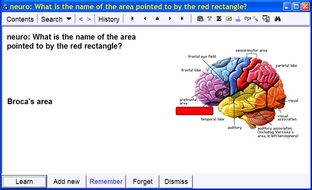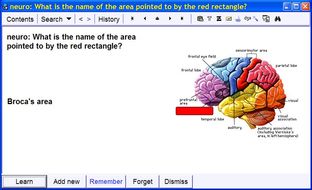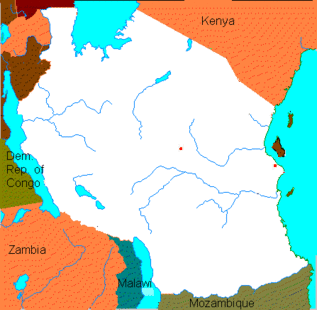Edited, memorised or added to reading queue
on 18-Sep-2015 (Fri)
Do you want BuboFlash to help you learning these things? Click here to log in or create user.
| status | not read | reprioritisations | ||
|---|---|---|---|---|
| last reprioritisation on | suggested re-reading day | |||
| started reading on | finished reading on |
20 rules of formulating knowledge in learning
and effective method of converting textbook knowledge into knowledge that can be subject to learning based on spaced repetition. Cloze deletion makes the core of the fast reading and learning technique called incremental reading. <span>Ill-formulated knowledge - Complex and wordy Q: What was the history of the Kaleida company? A: Kaleida, funded to the tune of $40 million by Apple Computer and IBM in 1991. Hyped as a red-hot startup, Kaleida's mission was to create a multimedia programming language It finally produced one, called Script X. But it took three years. Meanwhile, companies such as Macromedia and Asymetrix had snapped up all the business. Kaleida closed in 1995 Well-formulated knowledge - Simple cloze deletion Q: Kaleida was funded to the tune of ...(amount) by Apple Computer and IBM in 1991 A: $40 mi
| status | not read | reprioritisations | ||
|---|---|---|---|---|
| last reprioritisation on | suggested re-reading day | |||
| started reading on | finished reading on |
20 rules of formulating knowledge in learning
Usually it takes much less time to formulate a simple question-and-answer pair than to find or produce a neat graphic image. This is why you will probably always have to weigh up cost and profits in using graphics in your learning material. <span>Well-employed images will greatly reduce your learning time in areas such as anatomy, geography, geometry, chemistry, history, and many more. The power of imagery explains why the concept of Tony Buzan's mind maps is so popular. A mind map is an abstract picture in which connections between its components reflect the logical c
| status | not read | reprioritisations | ||
|---|---|---|---|---|
| last reprioritisation on | suggested re-reading day | |||
| started reading on | finished reading on |
20 rules of formulating knowledge in learning
missing. The student's job is to name the missing area. The same illustration can be used to formulate 10-20 items! Each item can ask about a specific subcomponent of the image. Graphic deletion works great in learning geography! <span>Exemplary graphic deletion: SuperMemo 2000/2002 SuperMemo 99 This is how you can quickly generate graphic deletion using a picture from the clipboard: Press Shift+Ins to paste the pict
Flashcard 150915054
| status | not learned | measured difficulty | 37% [default] | last interval [days] | |||
|---|---|---|---|---|---|---|---|
| repetition number in this series | 0 | memorised on | scheduled repetition | ||||
| scheduled repetition interval | last repetition or drill |
Flashcard 150915071
| status | not learned | measured difficulty | 37% [default] | last interval [days] | |||
|---|---|---|---|---|---|---|---|
| repetition number in this series | 0 | memorised on | scheduled repetition | ||||
| scheduled repetition interval | last repetition or drill |
Parent (intermediate) annotation
Open itWell-employed mind map images will greatly reduce your learning time in areas such as anatomy, geography, geometry, chemistry, history, and many more.
Original toplevel document
20 rules of formulating knowledge in learningUsually it takes much less time to formulate a simple question-and-answer pair than to find or produce a neat graphic image. This is why you will probably always have to weigh up cost and profits in using graphics in your learning material. <span>Well-employed images will greatly reduce your learning time in areas such as anatomy, geography, geometry, chemistry, history, and many more. The power of imagery explains why the concept of Tony Buzan's mind maps is so popular. A mind map is an abstract picture in which connections between its components reflect the logical c
Flashcard 150915077
| status | not learned | measured difficulty | 37% [default] | last interval [days] | |||
|---|---|---|---|---|---|---|---|
| repetition number in this series | 0 | memorised on | scheduled repetition | ||||
| scheduled repetition interval | last repetition or drill |
Parent (intermediate) annotation
Open itDo not learn if you do not understand
Original toplevel document
20 rules of formulating knowledge in learningwill proceed with learning using spaced repetition, i.e. you will not just learn once but you will repeat the material optimally (as in SuperMemo). The 20 rules of formulating knowledge in learning <span>Do not learn if you do not understand Trying to learn things you do not understand may seem like an utmost waste of time. Still, an amazing proportion of students commit the offence of learning without comprehension. Very of
Flashcard 150915083
| status | not learned | measured difficulty | 37% [default] | last interval [days] | |||
|---|---|---|---|---|---|---|---|
| repetition number in this series | 0 | memorised on | scheduled repetition | ||||
| scheduled repetition interval | last repetition or drill |
Parent (intermediate) annotation
Open itLearn before you memorize Before you proceed with memorizing individual facts and rules, you need to build an overall picture of the learned knowledge . Only when individual pieces fit to build a single coherent
Original toplevel document
20 rules of formulating knowledge in learningand you may tend to blame yourself for lack of comprehension. Soon you may pollute your learning process with a great deal of useless material that treacherously makes you believe "it will be useful some day". <span>Learn before you memorize Before you proceed with memorizing individual facts and rules, you need to build an overall picture of the learned knowledge . Only when individual pieces fit to build a single coherent structure will you be able to dramatically reduce the learning time. This is closely related to the problem of comprehension mentioned in Rule 1: Do not learn if you do not understand. A single separated piece of your big picture is like a single German word in the textbook of history. Do not start from memorizing loosely related facts! First read a chapter in your book that puts them together (e.g. the principles of the internal combustion engine). Only then proceed with learning using individual questions and answers (e.g. What moves the pistons in the internal combustion engine?), etc. Build upon the basics The picture of the learned whole (as discussed in Rule 2: Learn before you memorize) does not have to be complete to the last detail. Just the opposite,
Flashcard 150915089
| status | not learned | measured difficulty | 37% [default] | last interval [days] | |||
|---|---|---|---|---|---|---|---|
| repetition number in this series | 0 | memorised on | scheduled repetition | ||||
| scheduled repetition interval | last repetition or drill |
Parent (intermediate) annotation
Open itLearn before you memorize Before you proceed with memorizing individual facts and rules, you need to build an overall picture of the learned knowledge . Only when individual pieces fit to build a single coherent structure will you be able to dramatically reduce the learning time. This is closely related to the
Original toplevel document
20 rules of formulating knowledge in learningand you may tend to blame yourself for lack of comprehension. Soon you may pollute your learning process with a great deal of useless material that treacherously makes you believe "it will be useful some day". <span>Learn before you memorize Before you proceed with memorizing individual facts and rules, you need to build an overall picture of the learned knowledge . Only when individual pieces fit to build a single coherent structure will you be able to dramatically reduce the learning time. This is closely related to the problem of comprehension mentioned in Rule 1: Do not learn if you do not understand. A single separated piece of your big picture is like a single German word in the textbook of history. Do not start from memorizing loosely related facts! First read a chapter in your book that puts them together (e.g. the principles of the internal combustion engine). Only then proceed with learning using individual questions and answers (e.g. What moves the pistons in the internal combustion engine?), etc. Build upon the basics The picture of the learned whole (as discussed in Rule 2: Learn before you memorize) does not have to be complete to the last detail. Just the opposite,
Flashcard 150915141
| status | not learned | measured difficulty | 37% [default] | last interval [days] | |||
|---|---|---|---|---|---|---|---|
| repetition number in this series | 0 | memorised on | scheduled repetition | ||||
| scheduled repetition interval | last repetition or drill |
Parent (intermediate) annotation
Open itExemplary graphic deletion example:
Original toplevel document
20 rules of formulating knowledge in learningmissing. The student's job is to name the missing area. The same illustration can be used to formulate 10-20 items! Each item can ask about a specific subcomponent of the image. Graphic deletion works great in learning geography! <span>Exemplary graphic deletion: SuperMemo 2000/2002 SuperMemo 99 This is how you can quickly generate graphic deletion using a picture from the clipboard: Press Shift+Ins to paste the pict
Flashcard 150915147
| status | not learned | measured difficulty | 37% [default] | last interval [days] | |||
|---|---|---|---|---|---|---|---|
| repetition number in this series | 0 | memorised on | scheduled repetition | ||||
| scheduled repetition interval | last repetition or drill |
Parent (intermediate) annotation
Open itGraphic deletion is as good as cloze deletion
Original toplevel document
20 rules of formulating knowledge in learningome automatic! Exemplary mind map: Six Steps mind map generated in Mind Manager 3.5, imported to SuperMemo 2004, courtesy of John England, TeamLink Australia) <span>Graphic deletion is as good as cloze deletion Graphic deletion works like cloze deletion but instead of a missing phrase it uses a missing image component. For example, when learning anatomy, you might present a complex illustration
Flashcard 150915153
| status | not learned | measured difficulty | 37% [default] | last interval [days] | |||
|---|---|---|---|---|---|---|---|
| repetition number in this series | 0 | memorised on | scheduled repetition | ||||
| scheduled repetition interval | last repetition or drill |
Flashcard 150915160
| status | not learned | measured difficulty | 37% [default] | last interval [days] | |||
|---|---|---|---|---|---|---|---|
| repetition number in this series | 0 | memorised on | scheduled repetition | ||||
| scheduled repetition interval | last repetition or drill |
Parent (intermediate) annotation
Open itBuild upon the basics The picture of the learned whole (as discussed in Rule 2: Learn before you memorize) does not have to be complete to the last detail. Just the opposite, the simpler the picture the bette
Original toplevel document
20 rules of formulating knowledge in learningt puts them together (e.g. the principles of the internal combustion engine). Only then proceed with learning using individual questions and answers (e.g. What moves the pistons in the internal combustion engine?), etc. <span>Build upon the basics The picture of the learned whole (as discussed in Rule 2: Learn before you memorize) does not have to be complete to the last detail. Just the opposite, the simpler the picture the better. The shorter the initial chapter of your book the better. Simple models are easier to comprehend. You can always build upon them later on. Do not neglect the basics. Memorizing seemingly obvious things is not a waste of time! Basics may also appear volatile and the cost of memorizing easy things is little. Better err on the safe side. Remember that usually you spend 50% of your time repeating just 3-5% of the learned material! Basics are usually easy to retain and take a tiny proportion of
Flashcard 150915168
| status | not learned | measured difficulty | 37% [default] | last interval [days] | |||
|---|---|---|---|---|---|---|---|
| repetition number in this series | 0 | memorised on | scheduled repetition | ||||
| scheduled repetition interval | last repetition or drill |
Parent (intermediate) annotation
Open itThe power of imagery explains why the concept of Tony Buzan's mind maps is so popular. A mind map is an abstract picture in which connections between its components reflect the logical connections between in
Original toplevel document
20 rules of formulating knowledge in learningly always have to weigh up cost and profits in using graphics in your learning material. Well-employed images will greatly reduce your learning time in areas such as anatomy, geography, geometry, chemistry, history, and many more. <span>The power of imagery explains why the concept of Tony Buzan's mind maps is so popular. A mind map is an abstract picture in which connections between its components reflect the logical connections between individual concepts. Less beneficial formulation Q: What African country is located between Kenya, Zambia and Mozambique? A: Tanzania More effective formulation Q: What African country is marked white on the map? A: Tanzania Use mnemonic techniques Mnemonic techniques are various techniques that make remembering easier. They are often amazingly effective. For most students, a picture of a 10-year
Flashcard 150915174
| status | not learned | measured difficulty | 37% [default] | last interval [days] | |||
|---|---|---|---|---|---|---|---|
| repetition number in this series | 0 | memorised on | scheduled repetition | ||||
| scheduled repetition interval | last repetition or drill |
Parent (intermediate) annotation
Open itWell-formulated knowledge - Simple cloze deletion Q: Kaleida was funded to the tune of ...(amount) by Apple Computer and IBM in 1991 A: $40 million Q: Kaleida was funded to the tune of $40 million
Original toplevel document
20 rules of formulating knowledge in learningate a multimedia programming language It finally produced one, called Script X. But it took three years. Meanwhile, companies such as Macromedia and Asymetrix had snapped up all the business. Kaleida closed in 1995 <span>Well-formulated knowledge - Simple cloze deletion Q: Kaleida was funded to the tune of ...(amount) by Apple Computer and IBM in 1991 A: $40 million Q: Kaleida was funded to the tune of $40 million by ...(companies) in 1991 A: Apple and IBM Q: Kaleida was funded to the tune of $40 million by Apple Computer and IBM in ... (year) A: 1991 Q: ...(company) mission was to create a multimedia programming language. It finally produced one, called Script X. But it took three years A: Kaleida's Q: Kaleida's mission was to create a ... It finally produced one, called Script X. But it took three years A: multimedia programming language Q: Kaleida's mission was to create a multimedia programming language. It finally produced one, called ... But it took three years A: Script X Q: Kaleida's mission was to create a multimedia programming language. It finally produced one, called Script X. But it took ...(time) A: three years Q: Kaleida's mission was to create a multimedia programming language: Script X. But it took three years. Meanwhile, companies such as ... had snapped up all the business A: Macromedia/Asymetrix Q: Kaleida's mission was to create Script X. But it took three years. Meanwhile, companies such as Macromedia and Asymetrix had snapped up all the business. Kaleida closed in ...(year) A: 1995 Optional: SuperMemo Recipe: SuperMemo 2004 SuperMemo 2000 SuperMemo 9 Creating
Flashcard 150915180
| status | not learned | measured difficulty | 37% [default] | last interval [days] | |||
|---|---|---|---|---|---|---|---|
| repetition number in this series | 0 | memorised on | scheduled repetition | ||||
| scheduled repetition interval | last repetition or drill |
Parent (intermediate) annotation
Open itIll-formulated knowledge - Complex and wordy Q: What was the history of the Kaleida company? A: Kaleida, funded to the tune of $40 million by Apple Computer and IBM in 1991. Hyped as a red-hot startup, Ka
Original toplevel document
20 rules of formulating knowledge in learningand effective method of converting textbook knowledge into knowledge that can be subject to learning based on spaced repetition. Cloze deletion makes the core of the fast reading and learning technique called incremental reading. <span>Ill-formulated knowledge - Complex and wordy Q: What was the history of the Kaleida company? A: Kaleida, funded to the tune of $40 million by Apple Computer and IBM in 1991. Hyped as a red-hot startup, Kaleida's mission was to create a multimedia programming language It finally produced one, called Script X. But it took three years. Meanwhile, companies such as Macromedia and Asymetrix had snapped up all the business. Kaleida closed in 1995 Well-formulated knowledge - Simple cloze deletion Q: Kaleida was funded to the tune of ...(amount) by Apple Computer and IBM in 1991 A: $40 mi


